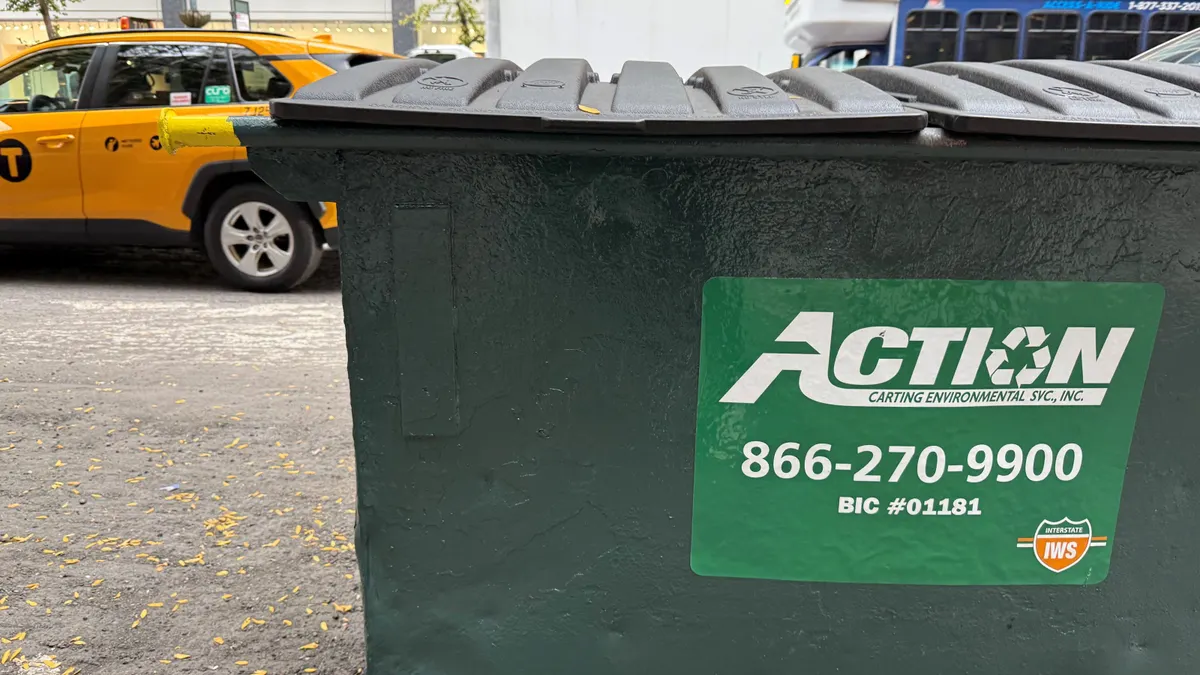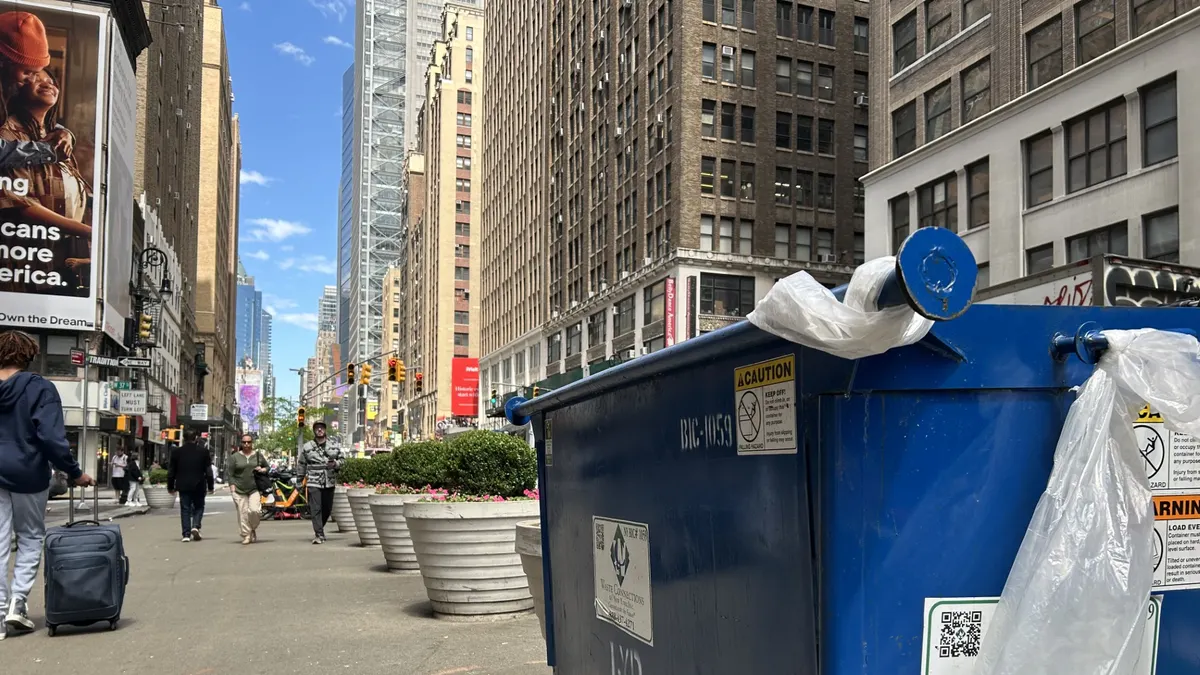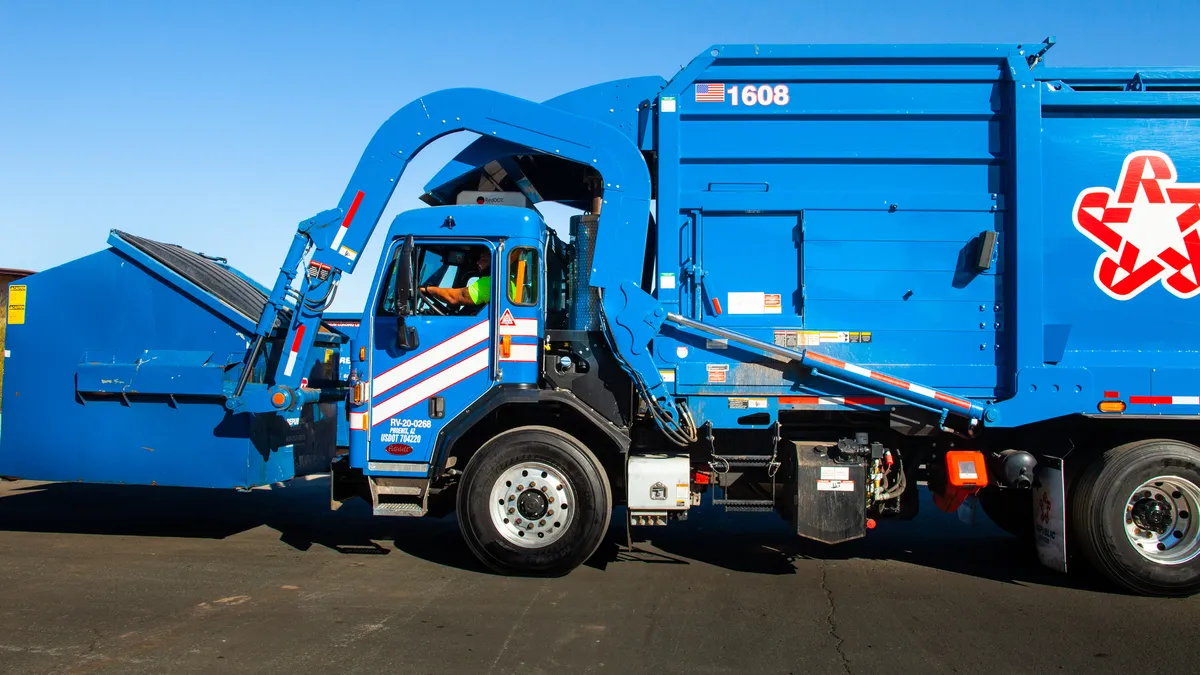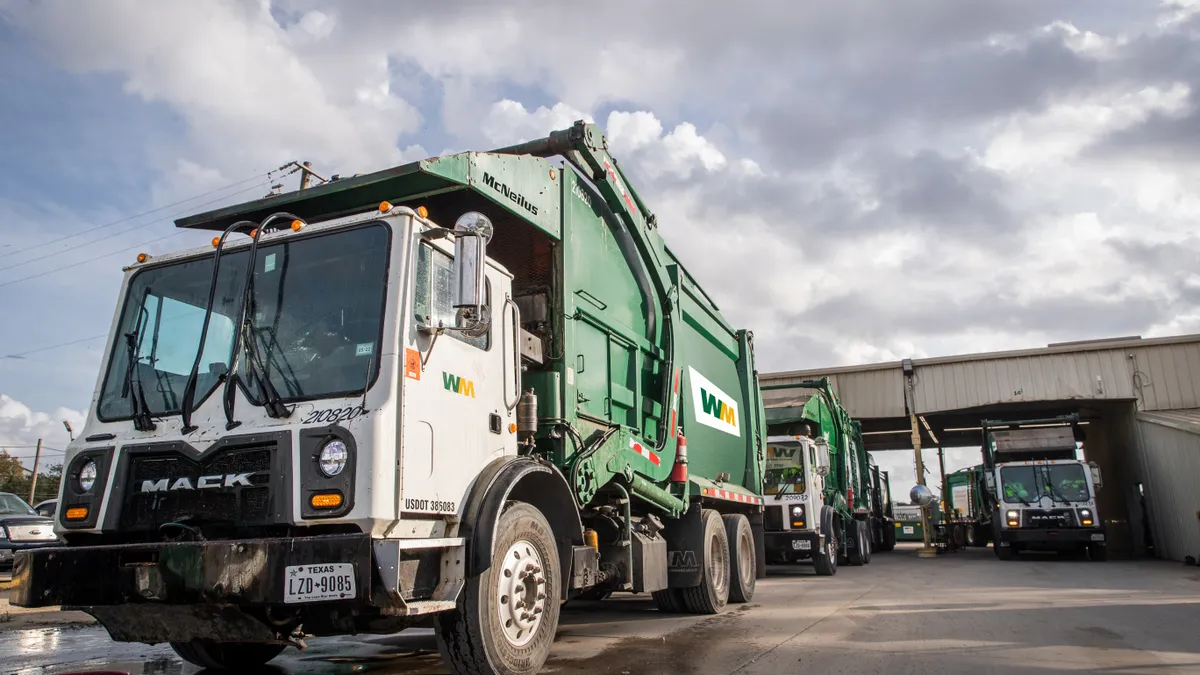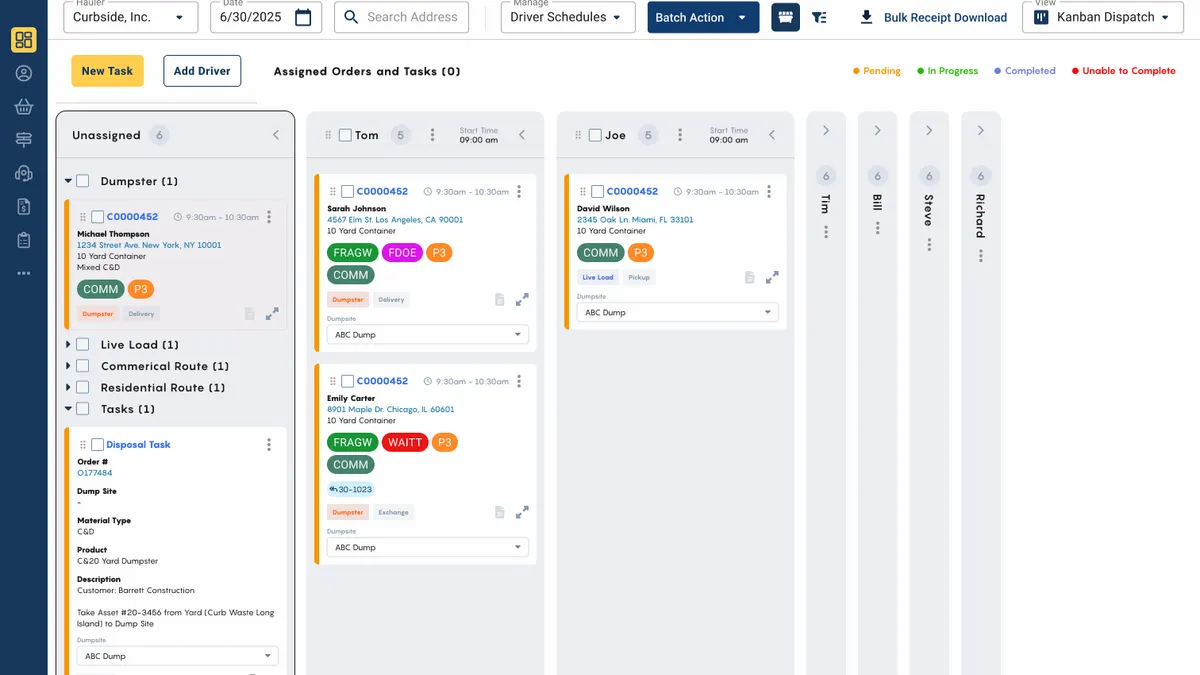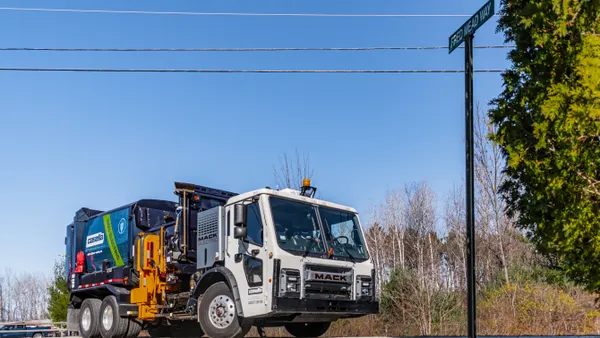Note: This article has been updated to reflect new details on the involvement of various stakeholders
The ongoing debate about safety reforms in New York's commercial waste industry has led to a potential new area of common ground. In what is believed to be a first for any city, the local regulatory authority is releasing a free "Trade Waste Safety Manual."
This voluntary manual, shared first with Waste Dive by the Business Integrity Commission (BIC), was developed over months of meetings with input from stakeholders including the Department of Sanitation (DSNY), the National Waste & Recycling Association, the Solid Waste Association of North America, New Yorkers for Responsible Waste Management, Waste Connections and multiple local companies, Teamsters Local 813, Laborers Local 108, the Transform Don't Trash Coalition and Transportation Alternatives.
The final product doesn't include everything that some of those stakeholders had hoped for, but BIC sees it as a baseline for companies of all sizes to enhance existing safety culture for employees during every point of their shift.
Improving safety has been a core element to ongoing reform efforts, including DSNY's commercial waste zone plan. BIC Commissioner Dan Brownell said the idea originated from the city's initial zone stakeholder meeting in Sept. 2016 as a way to drive change sooner than the multi-year process of hiring consultants and waiting for potential legislation could.
The chance for voluntary progress outside of that process offered an opportunity for all involved. The industry could show it was capable of change without franchising. Labor and advocacy groups could help influence working conditions sooner. BIC could further step into its expanding role as more than a licensing enforcer.
"With regard to improving safety in the industry, well that's really something that can be very much separate from consultants," said Brownell. "Improving safety in a very dangerous industry, in a densely populated city, is something that we should be working together on and using the terrific resources of a group of stakeholders like that from every side of the trade waste industry."
Following this release, BIC is now working on short training videos to highlight certain sections and is also pursuing rule changes. Legal details are still being assessed, though this could include making adoption of the manual mandatory in some form and tightening regulations on driving hours.
Until then, the hope is that companies will use this manual to evaluate their own practices and coach workers in an effort to eliminate what critics have previously described as a "wild west" image.
1. "Safe Start to the Day"
The manual's initial section covers basic elements for workers to protect themselves and the public, such as driving conditions, uniform recommendations and vehicle inspection reports.
Getting sufficient rest between shifts is the very first piece of guidance. "Drowsy driving can slow reaction time and impairs judgment not unlike using drugs or alcohol," the manual reads.
- Federal guidelines on length service are more geared toward long-haul truckers, so BIC's lawyers are working to gain clarity on how they should be applied to overnight collection routes. This has involved collaboration with DSNY and is expected to be one of their next rulemaking priorities.
"I think this is one of the huge, huge problems in this industry," said Brownell. "The drivers and helpers work hours that are way too long so that they get tired and then it becomes dangerous."
- This section also focuses on expected hazards during a collection route, avoiding accessories such as headphones or jewelry, and what standard personal protective equipment (PPE) companies should be providing per the Occupational Safety and Health Administration (OSHA). Local PPE requirements could be another area addressed by potential rules.
Detailed information is included on how to complete a Driver Vehicle Inspection Report (DVIR) both pre- and post-trip, along with a sample DVIR. Keeping a regular tab on vehicle condition can help prevent breakdowns mid-route, though if that does occur the manual stresses companies should "never put completion of a route above driver and public safety."
2. "On the Collection Route"
Along with a refresher on New York state traffic laws, and basic guidance around limiting cell phone usage and distractions, this section has key information to prevent collisions in any city.
- Keep a six-second stopping distance between the closest vehicle, and add additional time during inclement weather.
- Be aware of pedestrians, cyclists and other vehicles in intersections, especially when turning. "Cover your brake. Never accelerate through an intersection. Both the driver and helper should check corners for pedestrians, cyclist and other trucks," the manual says.
- On backing: "You should train your drivers to avoid backing up all together. If they miss a collection stop, they should go around the block. Pedestrians have been struck and killed by trade waste trucks backing." If backing is required, the manual says to never do so in intersections or when a helper is on the rear step.
The manual doesn't take any specific positions on required safety equipment beyond existing regulations, but does lay out a range of potential options.
3. "Safe Collection Stops"
For workers that may get in and out of their trucks hundreds of times per night, having a routine is crucial to avoid injuries to themselves or the public. The manual outlines several steps workers can take to keep themselves safe and healthy during stops.
- "As you slow down, indicate you are about to stop by using the turn signal, strobe lights, or 4-way flashers. Pedestrians, cyclists, and motorists need to know what to expect," the manual reads.
- "Take a moment to examine the load and surrounding area. If the bag is ripped or the load is too heavy, too large, or too awkward, stop and get help." Lifting must be done in proper form to avoid muscle or joint injury. "You should not feel pain when lifting."
Safe handling and maintenance of containers is also covered. Once material from bags or containers is collected, workers should remember a cardinal rule: "Always stand to the side of the truck when cycling the hopper. If you stand directly behind the truck, you can be struck by the debris that is being crushed.”
4. "End of the Shift"
After a long shift that may involve hundreds of stops, workers may want to get home as soon as possible. The manual asks companies to remind employees that safety during the end of the shift, and in the garage or yard, is no less important than safe practices while out in the field.
- This includes the completion of a DVIR, signed by both the driver finishing their shift and the one heading out next if present, as well as a mechanic if repairs are needed.
- "By the end of a shift, the hopper may have been cycled up to 100 times. Perform a thorough inspection of the hopper and hydraulics as part of your DVIR," the manual reads.
Basic measures such as a safety meetings, procedures for handling hazardous material on site and moving vehicles around the yard may be overlooked by tired workers, but are important to consider.
5. "When Things Go Wrong"
Opinions vary about how bad conditions are in New York's commercial waste industry, or what it might take change to them, but no one disputes that incidents have happened and will likely happen again. If they do, BIC wants to see basic policies in place for how companies respond in an emergency.
- If a breakdown occurs, drivers are advised to pull out of traffic, maximize visibility, call dispatch and keep the public clear. If a fire occurs, drivers should be prepared to dump their loads if necessary.
- If a collision occurs, drivers should have a packet in their truck with step-by-step instructions and important phone numbers. Ideally, a camera would also be in place to record. The manual advises having several materials on hand, including hazard triangles, a fire extinguisher and a first aid kit.
- "No one wants to deal with a collision, but when one happens, try to learn from it," the manual reads. "Create a collision review team to analyze collisions and how you can improve safety equipment and driver training to prevent future collisions."
- The need for accountability, both positive and disciplinary, is also highlighted. Good ideas and decisions should be recognized. Conversely, an infraction policy should be in place to address bad decisions or involvement in any kind of incident.
- Based on existing policies at some local companies, and input from stakeholders, BIC recommends three infractions levels — preventable, serious and severe — with varying consequences that could include termination.
Next Steps
As more people move to cities such as New York, that means more pedestrians and cyclists are out on every street corner at every hour. Recent crashes involving BIC-registered trade waste vehicles have resulted in multiple fatalities, making the situation even more urgent.
This voluntary manual won't end the increasingly heated safety debate in New York, or other parts of the country, but it will at least provide an added measure of accountability for companies in terms of safety expectations and a starting point for new conversations.
"From all sides the push for greater safety is really escalating," said Brownell. "It'll be interesting to see how the industry responds to that, and what real improvements can made."
Coming up, BIC will be co-hosting its fourth safety symposium in April at DSNY's Floyd Bennett Field training facility. A half-day program of informational sessions, equipment education and truck demonstrations are scheduled for the event.



